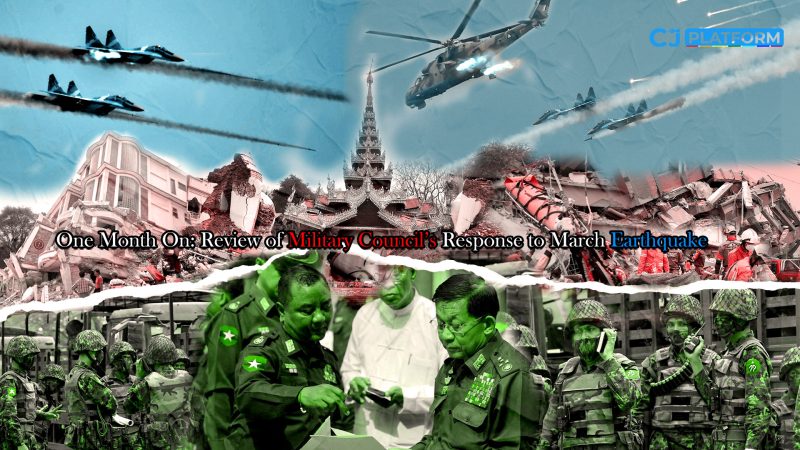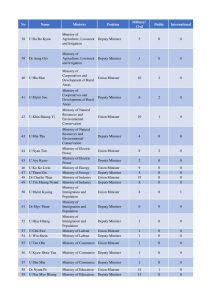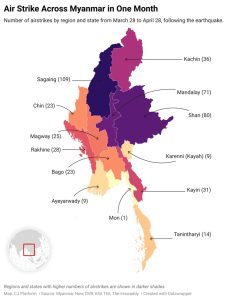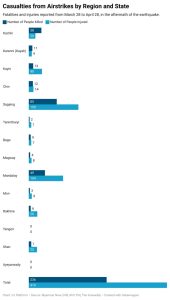One Month On: Review of Military Council’s Response to March Earthquake

Introduction
A powerful 7.7-magnitude earthquake—the strongest to hit Myanmar in 186 years—struck near Sagaing Township at around 12:51 p.m. on March 28, 2025, causing widespread destruction across the country. The quake affected multiple regions, including Sagaing, Mandalay, the Nay Pyi Taw Council Area, and Shan State.
On the same day, the military council declared a state of emergency in the earthquake-affected areas—including Sagaing Region, Mandalay Region, the Nay Pyi Taw Council Area, Magway Region, northeastern Shan State, and Bago Region—under the National Disaster Management Law.
Following the declaration, military chief Senior General Min Aung Hlaing formally appealed for international assistance. Since then, the military council has repeatedly cited the Sagaing earthquake in its ongoing efforts to engage with the international community, according to junta-aligned media reports.
Part (1)
Damages in Earthquake
As of April 24, the earthquake had claimed 3,763 lives, injured 5,107 people, and left 110 missing, according to military council reports. The disaster also damaged 63,584 homes, 6,752 schools, 5,474 monasteries and nunneries, 5,342 pagodas and temples, 613 other religious buildings, 576 hospitals, 56 railways, 271 roads, 198 expressways, 586 dams and embankments, 172 bridges, and 353 transformers.
Cash Donations to Military Council
According to junta-controlled media, the military council has received over 115.876 billion kyats in donations, along with foreign contributions including US$2.437 million, 5 million Korean won, 15 million Indian rupees, 2 million Thai baht, and S$3,150 as of April 24.
Additionally, a total of 2,635.92 tons of international relief supplies and 1,197 tons of domestic aid materials had been delivered to Myanmar by that date, according to the same reports.
What Was the Military Council Doing During the Disaster Earthquake?
Monitoring of state-run military media from March 28 to April 28 indicates that junta chief Senior General Min Aung Hlaing used the earthquake’s aftermath as a pretext to ramp up foreign engagements. During this period, he visited India, Pakistan, Malaysia, and Nepal, and worked to strengthen ties with countries like Thailand.
On April 4, he attended the 6th BIMSTEC (Bay of Bengal Initiative for Multi-Sectoral Technical and Economic Cooperation) Summit in Bangkok, under Thailand’s rotating chairmanship. While there, he held separate meetings with the prime ministers of Nepal, Sri Lanka, Thailand, India, and Bhutan, as well as the BIMSTEC Secretary-General, according to reports in military-controlled media.
After returning to Myanmar on the evening of April 4, he continued his diplomatic efforts by receiving the foreign ministers of Malaysia and Thailand in Nay Pyi Taw the following day. The military council later announced that a private meeting took place on April 17 between Min Aung Hlaing and Malaysian Prime Minister Anwar Ibrahim—ASEAN’s rotating chair—during which they discussed earthquake relief efforts and ASEAN-Myanmar cooperation.
From March 28 to April 28, the junta chief met with earthquake-affected civilians and businesspeople 25 times, military and civilian departments 10 times, and foreign diplomats or international governments 18 times. Meanwhile, deputy junta leader Lieutenant General Soe Win held 11 meetings with earthquake-affected people and business figures, 9 meetings with military departments, and 5 meetings with foreign diplomats and governments.
Have Earthquake Victims Really Received Relief Assistance?
In the aftermath of the earthquake, questions have arisen over the effectiveness of the military council’s relief efforts. Official records suggest that key government officials showed limited engagement with the public during the critical period.
Dr. Soe Win, the Union Minister for Social Welfare, Relief and Resettlement—who bore primary responsibility for disaster response—met with the public only three times. In contrast, he held eight meetings with military and civil personnel and just three visits to directly assist earthquake victims. He also met four times with international diplomats and foreign officials.
Deputy Minister U Soe Kyi did not meet with the public at all, although he held five meetings with military and departmental personnel.
In stark contrast, U Than Swe, the Minister for Foreign Affairs and Deputy Prime Minister, focused heavily on international relations. He met with international diplomats and foreign government officials 22 times, while his deputy, U Lwin Oo, held four such meetings and five additional meetings with foreign officials.
Meanwhile, the junta chief assigned multiple union ministers and deputy ministers to the various Offices of the Chairman of the State Administration Council (Offices 1–4). Of these, only the ministers at Offices 1 and 2 appeared active in the month following the disaster. The others were largely inactive.
Between March 28 and April 28, officials from the State Administration Council—including union ministers, deputy ministers, and permanent secretaries—met with the public just 88 times. In comparison, they held 372 meetings with military and civil personnel and 87 meetings with foreign diplomats and governments.
These figures are based on public reports from junta-aligned media outlets such as Myanma Alin, The Mirror, Myawaddy, and MRTV. While the military council frequently publicizes its visits to affected areas, it provides limited transparency regarding meetings with international organizations. Therefore, the actual number of such meetings may be higher than reported.
Findings
The March 28 earthquake not only devastated public infrastructure but also severely affected the administrative capital, Nay Pyi Taw. Verified records of public engagements suggest that the military council has shown indifference to the suffering of the people in the aftermath of the disaster. Furthermore, evidence indicates that the junta is using the earthquake as a strategic opportunity to enhance its engagement with the international community for its own benefit.
The activities of the military council in the month following the earthquake are illustrated in Figures (1), (2), (3), and (4).

Table (1) Summary of the Military Council’s activities in one month (Military/Civil refers to military responsibilities or departmental functions. Public means to non-departmental matters related to the public. International represents communication with other countries.)
References: The Myanma Alin, The Mirror, and Myawaddy newspapers, as well as MRTV and Wikipedia

Figure (2) Summary of the military council government’s activities in one month

Figure (3) Summary of the military council government’s activities in one month

Figure (4) Summary of the military council government’s activities for the month
Part (2)
What Is the Military Council Doing While Failing to Provide Humanitarian Aid?
While junta deputy chief Lt. Gen. Soe Win was occupied with the coup leader’s international engagements, he also held the role of chairman of the National Disaster Management Committee, making him directly responsible for overseeing earthquake relief efforts.
Over the course of one month, his international activities included meetings with representatives from international relief organizations, including the United Nations Office for the Coordination of Humanitarian Affairs (UNOCHA) and the International Committee of the Red Cross (ICRC), ostensibly to discuss earthquake-related aid.
The military council’s Ministry of Foreign Affairs (MOFA) played a key role in post-earthquake efforts to engage the international community. MOFA held meetings with foreign ministers from ASEAN and BIMSTEC member countries. It also engaged with several UN agencies, including the Office of the United Nations High Commissioner for Refugees (UNHCR), the World Food Programme (WFP), the UN Office for the Coordination of Humanitarian Affairs (UNOCHA), and the International Organization for Migration (IOM), along with other international non-governmental organizations.
The military council appears to be using the March 28 earthquake as a pretext to increase engagement with the international community, which had largely isolated the junta since the 2021 coup. According to local media reports, the disaster is also being exploited to strengthen another critical pillar of the regime’s survival: the military.
The Military Council’s Ceasefire: More Rhetoric Than Reality
Following the earthquake, the northern-based Three Brotherhood Alliance—the Myanmar National Democratic Alliance Army (MNDAA), the Ta’ang National Liberation Army (TNLA), and the Arakan Army (AA)—announced on March 29 that they would provide humanitarian assistance to affected communities. That same day, the National Unity Government (NUG) declared a unilateral ceasefire in earthquake-hit areas, suspending all offensive operations from March 30 to April 12, except for defensive actions.
In contrast, the military council delayed its response. It did not announce a ceasefire until April 2—six days after the quake—declaring a temporary truce from April 2 to 22, ostensibly to allow for emergency relief and rehabilitation.
Shortly after the junta’s announcement, the Kachin Independence Organization (KIO) also declared a ceasefire for the same period. However, the military’s ceasefire was widely criticized for being riddled with vague conditions. Local media reports revealed that, despite the declaration, the military continued to launch air and ground assaults, including the use of heavy weapons.
On April 22, the military council extended its ceasefire to April 30. Yet, attacks reportedly continued nationwide throughout the period.
An analysis of reporting from four independent media outlets—Myanmar Now, DVB, Khit Thit, and The Irrawaddy—reveals that the military council conducted airstrikes daily from March 28 to April 28, the entire month following the earthquake.
At least 459 airstrikes were documented across the country in that period. These included attacks carried out by jet fighters, drones, and paramotors. In many cases, only a single strike per incident was recorded due to limited access and verification, suggesting the actual number may be significantly higher.
* The number of airstrikes by the military council across the country and by region and state during the month can be seen in Figure (5) below.

Figure (5)
A map illustrating the military council’s airstrikes by region and state over a one-month period following the earthquake. The data shows that airstrikes were carried out daily in 13 regions and states across the country—excluding only Yangon Region.
In the month after the earthquake, the military council’s airstrikes reportedly killed at least 236 people and injured 419 nationwide. However, the actual number of casualties is likely higher, as some attacks could not be fully documented due to access restrictions and ongoing conflict.
- A detailed breakdown of fatalities by region and state can be found in Table (6)

Figure (6)
Number of casualties caused by the military council’s airstrikes across the country from March 28 to April 28.
Conclusion
The data presented in Figures (1), (2), (3), and (4) highlights the military council’s prioritization of international engagement while people in earthquake-affected areas faced dire conditions. During the one-month period following the disaster, the regime held only 88 meetings with the public, yet carried out at least 459 airstrikes across the country—even after declaring a ceasefire.
According to junta-released figures, the earthquake resulted in 3,763 deaths as of April 24. In addition, military airstrikes during the same period caused at least 236 civilian deaths and 419 injuries.
In Brief
The military council exploited the worst earthquake in 186 years to gain international attention, while largely neglecting the suffering of its own people. Despite a declared ceasefire and international recognition of the humanitarian crisis, the junta continued airstrikes and military operations aimed at instilling fear and suppressing resistance.
Link to get the full report. Link

